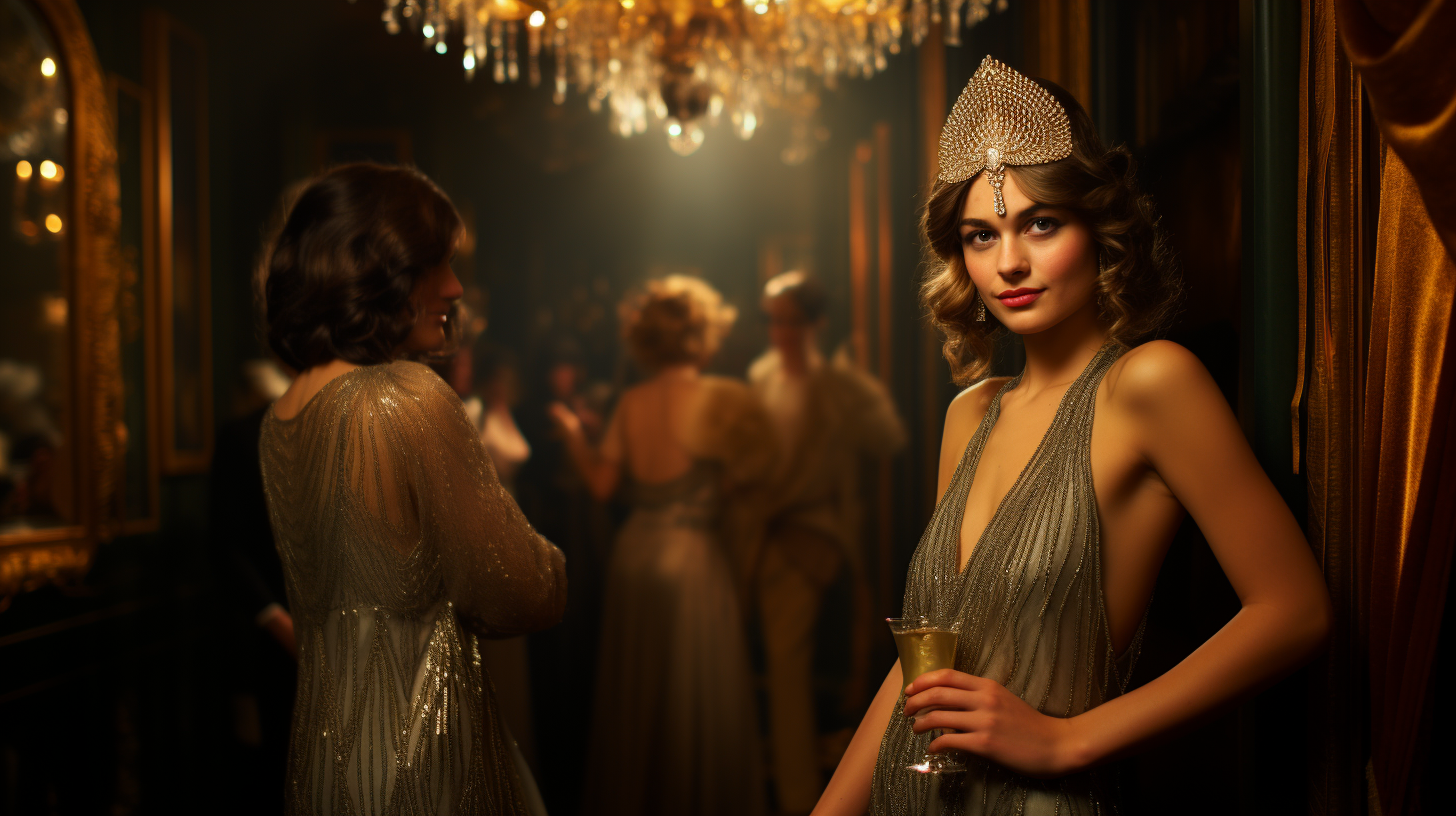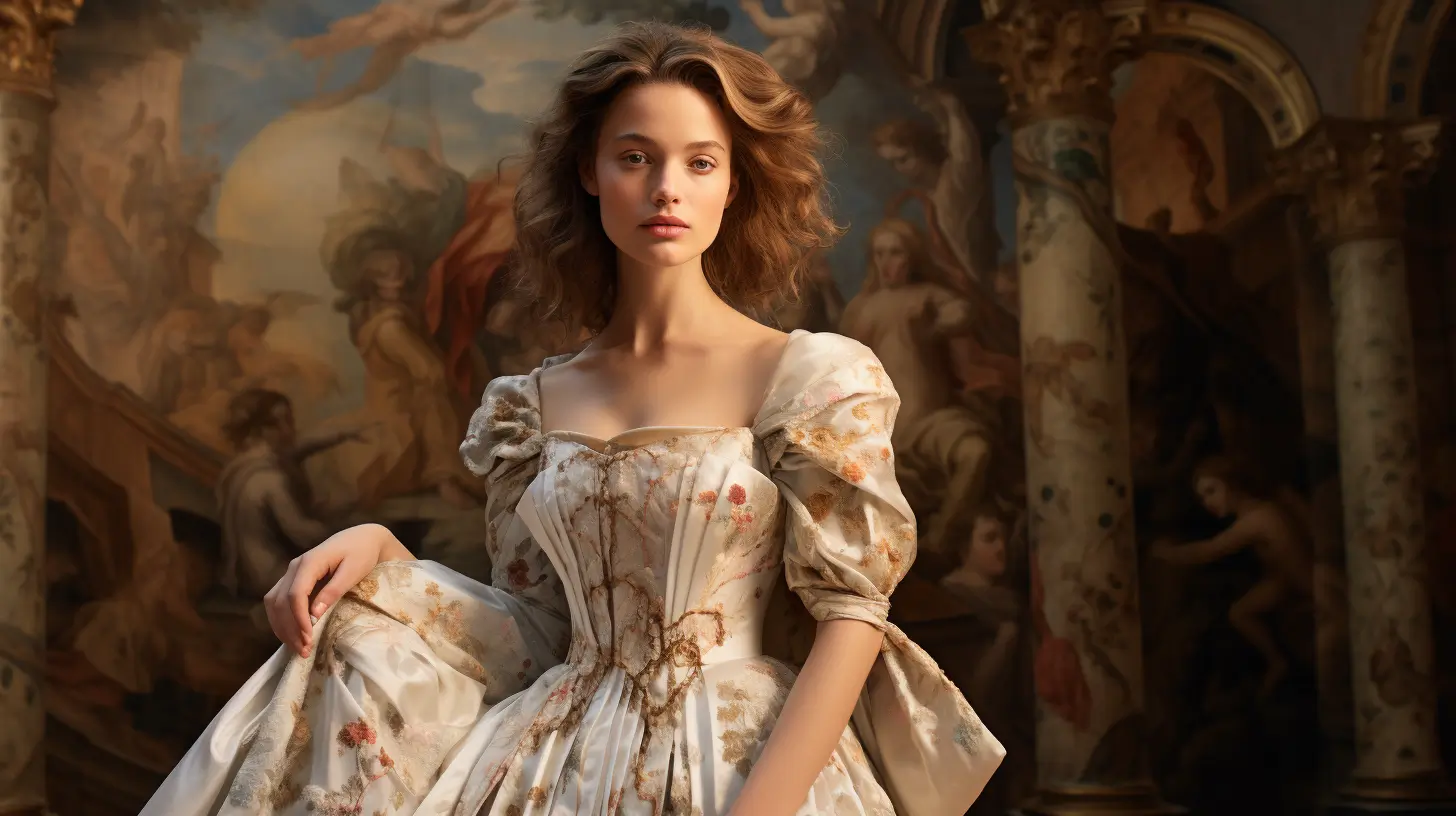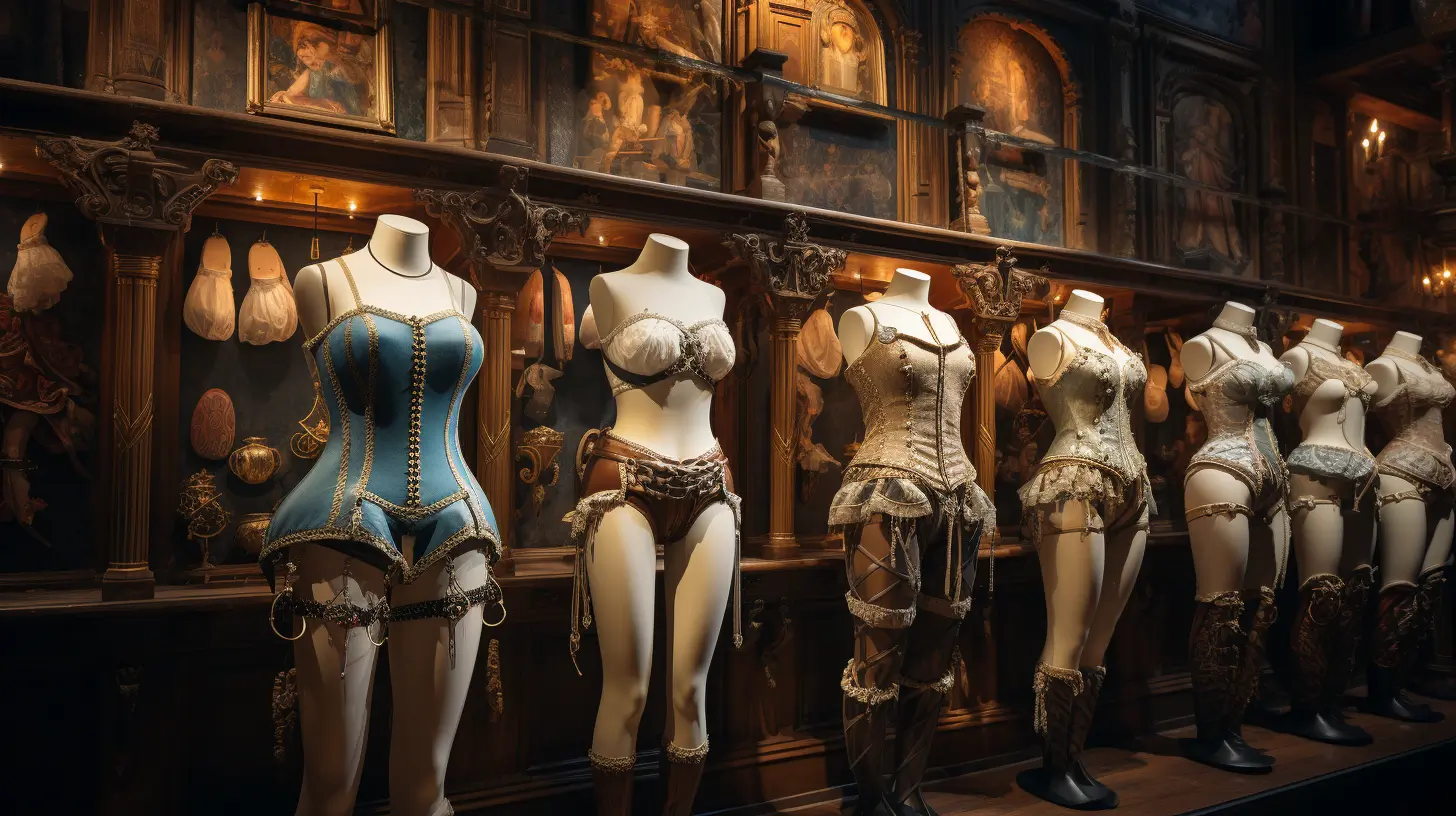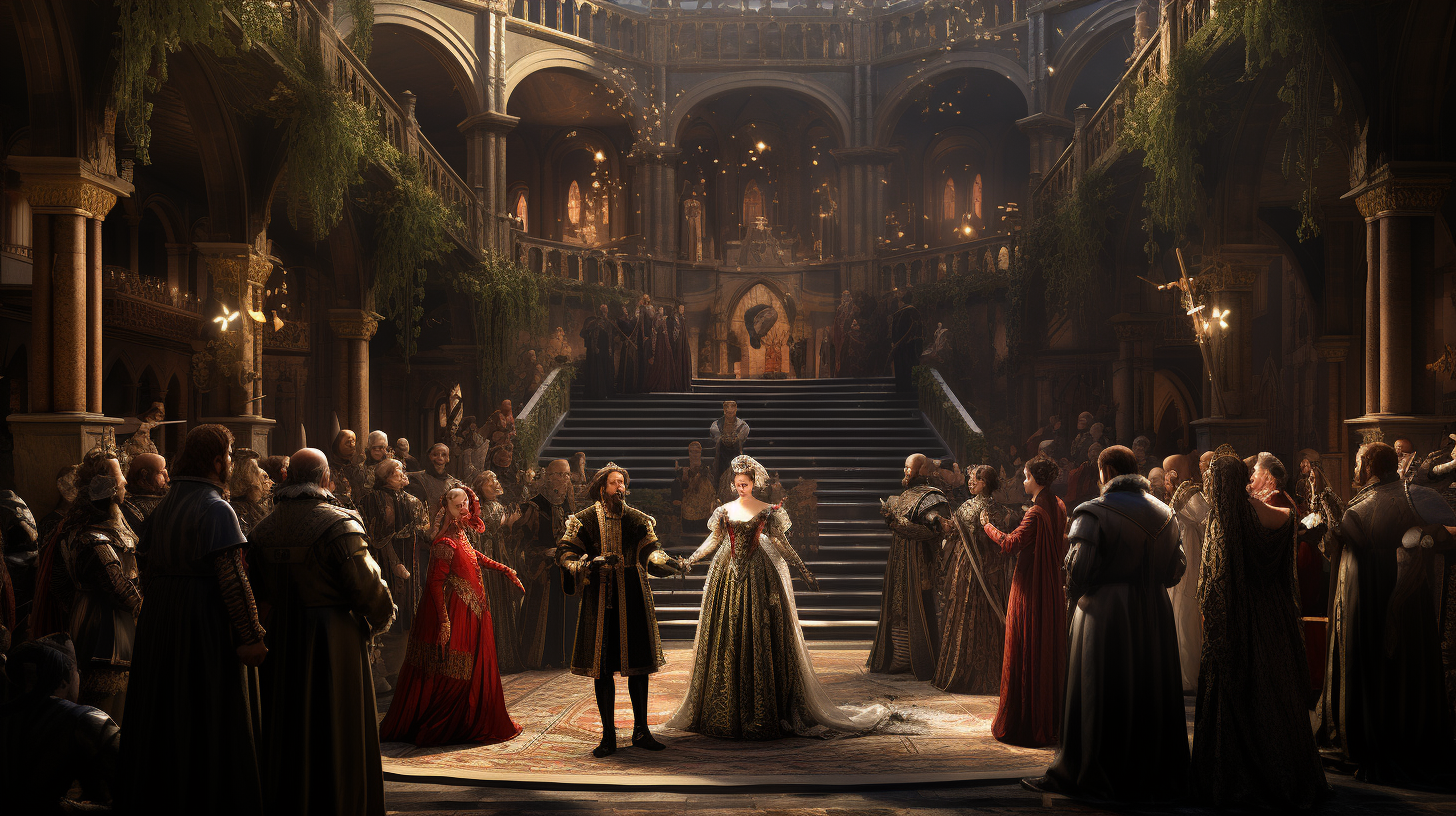
Flapper Fashion: The Iconic Style of the Roaring Twenties
Whispering Hemlines and the Echoes of Jazz
In an era where the night was a canvas and the music a pulsating heartbeat, there emerged a style so daring, so exuberant, it rewrote the script of fashion forever. The 1920s: a decade synonymous with liberation, jazz, and the unmistakable silhouette of the flapper fashion in the 1920s. This was the epoch of the flapper, a term that conjured images of vivacious women, radiating confidence with every twinkling bead and swishing fringe.
Imagine, if you will, the ballrooms infused with the smoky melodies of jazz bands, where the light catches on shimmering gowns that dance to the same rhythm as the women who wear them. It was a revolutionary time when fashion was not just about the garments; it was a bold statement, a defiant stride towards modernity.
Flapper fashion was far more than clothing; it was an armor of self-expression, worn by women who were no longer content to be in the shadows. They took to the streets and the speakeasies, their dresses a declaration of freedom, the loose fits and raised hemlines mirroring their liberated spirits. This was the era when fashion took a frolicsome twist, and women took a significant leap towards gender equality.
The fabric of society was transforming, and with it, the very weave of women’s attire. The flapper dress, with its straight, loose silhouette, freed women from the confines of corsetry, symbolizing their emancipation. With dropped waists and rising skirts, these dresses swung gleefully to the Charleston, the Shimmy, and the Fox Trot, capturing the ebullient spirit of the times.
As a beacon of this resplendent era, the fashion was far from mere aesthetics. It was a cultural revolution, visible in every sequin and heard in the clink of beaded necklaces. It marked an age where women’s voices grew louder, their choices bolder, and their fashion a reflection of this newfound audacity.

The Essence of Flapper Fashion
At the heart of the Roaring Twenties was a silhouette that broke all the rules. Let’s unravel the enigma of the flapper ensemble piece by piece.
The Roaring Twenties Silhouette
Picture the quintessential flapper dress: it defies the corseted, hourglass figures of previous decades and introduces a freedom of form unprecedented in women’s fashion. The silhouette is straight and loose, a cascade of fabric that falls from the shoulders to the knees with grace. It’s an androgynous shape, giving women the liberty to dance, work, and move with ease. This silhouette is the very embodiment of the era’s zest for life, a sartorial echo of society’s break from rigid traditions.
The Rise of the Hemlines
The 1920s saw a daring migration of the hemline, a rise that symbolized much more than a mere fashion trend. As hemlines ascended to the knee, they brought with them a wave of liberation. This shift in dress length coincided with the women’s suffrage movement, embodying the spirit of emancipation. The raised hemlines also provided a practicality for the active lifestyle that women were increasingly leading, allowing them to stride, dance, and drive cars with an ease that was previously denied to them in the cumbersome attire of the past.
Materials and Textures
In a tactile narrative of the decade, the materials and textures of flapper fashion speak volumes. Fabrics were chosen for their ability to sway and shimmer. Silk, taffeta, and chiffon were among the favorites, allowing for a fluid movement that matched the energetic dances of the time. Velvets added depth and warmth for the cooler months, while beads and sequins provided a sparkling ornamentation that reflected the exuberance of the flapper. Fringes added the final touch, creating a dynamic visual spectacle with every step, every twist, and turn on the dance floor.
Iconic Flapper Garments
Step into the wardrobe of the 1920s, where the attire speaks of boldness and rebellion against the established norms. Each piece tells a story, a narrative of newfound freedom and expression.
The Quintessential Flapper Dress
Imagine the iconic flapper dress, the cornerstone of the era’s fashion revolution. It’s a garment that speaks not in whispers but in jubilant shouts. The dress falls just below the knee, adorned with layers of beads, sequins, and fringes that dance to the rhythm of jazz. Its straight and loose fit is a testament to the era’s defiance, a stark contrast to the constricting fashions of the past. These dresses weren’t just attire; they were a declaration of independence, a banner for the modern woman who was no longer content to be merely seen and not heard.
Undergarments and Hosiery
Beneath the shimmering surfaces, the revolution continued. Corsets were discarded, replaced by bandeaux or simple slips that allowed the straight silhouette of flapper dresses to shine unimpeded. Stockings, now more visible than ever due to the raised hemlines, became a fashion statement in themselves. Silk and rayon hugged the legs, often adorned with intricate patterns or faux seams up the back, a subtle nod to the seductive yet sophisticated style of the time.
Outerwear and Evening Coats
Even in chillier weather, the flapper’s fashion sense didn’t falter. Evening coats and outerwear were cut to complement the flapper dress, often featuring clean lines and luxurious fabrics like velvet and fur. The coats, while more structured, still allowed for the freedom of movement essential to the flapper lifestyle. These were not merely for warmth but were another accessory to the era’s statement of opulence and modernity.
Embellishments and Details
Within the vivacious spirit of the Roaring Twenties, the flapper dress was the canvas for a myriad of intricate adornments, each an ode to the era’s daring aesthetics.
Beads, Fringes, and Sequins
Darlings, let’s visualize the quintessential flapper dress shimmering under the chandeliers of a grand ballroom. It’s embellished with beads that catch the light, sequins that sparkle like the champagne bubbles, and fringes that sway with every step. The movement of these dresses was a mesmerizing display, a flirtation with fun and freedom. Each strand of fringe was not merely a decorative element but a stroke of rebellion, an emblem of the flapper’s unapologetic confidence.
Embroidery and Art Deco Influences
Now, imagine the elegance of the embroidery, inspired by the Art Deco movement, that graced these garments. Geometric patterns, symmetrical designs, and lavish ornamentation defined the luxuriousness of the time. The influence of Art Deco was unmistakable, infusing fashion with an architectural precision and modern flair that was as refreshing as it was exquisite.
The Flapper’s Signature Handkerchief Hem
And then, there’s the signature handkerchief hem, a detail as deliberate as it was stylish. It wasn’t just an uneven line at the bottom of a skirt; it was a statement. This playful hemline gave the illusion of length and sophistication while allowing for the unrestrained movement that matched the dynamic life of the flapper. It was, in every sense, a reflection of the free spirit that defined the decade.
The Flapper’s Accessories
In the constellation of Flapper fashion, accessories were the twinkling stars that completed the firmament. Let’s glide through the paramount pieces that were essential to the flapper’s panache.
The Cloche Hat and Its Symbolism
First, envisage the Cloche Hat, a bell-shaped marvel that hugged the head, a chapeau that was more than mere fabric—it was the Flapper’s halo. Its snug fit was a sculptural grace that whispered of modernity, framing the face to reveal eyes that spoke of newfound boldness. The Cloche was not just a hat; it was a crowning emblem of the era’s forward-thinking and a visual shorthand for the age’s liberating ethos.
Jewelry: Pearls and Art Deco Designs
Now, let us turn our attention to the neck, draped with strands of pearls, layered as if to mirror the boldness of their wearer. The Flapper’s jewelry box was a trove of Art Deco masterpieces, where each geometrically inspired piece, each angular bracelet, each sharp-edged brooch served as a homage to the technological progress and the exuberant lifestyle of the twenties.
Shoes: T-Straps and Mary Janes
Finally, the T-Strap and Mary Jane shoes were not merely footwear; they were the foundation of the Flapper’s audacious stride. These were the pedestals for the feet that tapped to jazz rhythms, that danced until dawn. They married form and function with a chic simplicity, and their buckles caught the light, winking with every foxtrot or Charleston danced on the gleaming floors of the era’s ballrooms.
Hair and Makeup: A Bold Statement
Dive headfirst into the revolutionary tide of Flapper fashion in the 1920s, where the hair and makeup were as audacious and spirited as the jazz age itself. Let’s unravel these defining aspects that composed the quintessential look of a Flapper, narrated with the flair of Paul Mitchell, the maestro of hair.
The Bob: A Cut Above the Rest
The Bob was not just a haircut; it was a declaration of independence, a snip at the binds of tradition. With each lock that fell to the floor, women declared their autonomy. This iconic style, cropped close to the face with clean, straight lines, exuded an allure that was both chic and controversial. It was the cut that sheared through societal expectations, giving rise to an emblem of freedom that was as sharp as it was stylish.
Makeup Trends: Kohl Eyes and Cupid’s Bow Lips
Moving to the canvas of the face, the artistry of makeup in the Flapper era was bold and unapologetic. Kohl-rimmed eyes were windows to a soul that longed for excitement, mystery, and a touch of drama. The Cupid’s Bow lips, meticulously painted to perfection, spoke without uttering a single word, and the cheeks, rouged just so, were like blooms of vitality on the visage of the modern woman.
The Influence of Hollywood on Beauty Standards
Hollywood’s glitterati cast a sparkling shadow on the beauty ideals of the twenties. The silver screen was not just a medium of entertainment; it was a mirror that reflected the bold new standards of beauty. Women across America and beyond took their cues from the luminous faces of Clara Bow and Louise Brooks, emulating their every look, setting the foundations for celebrity-influenced beauty trends that would stretch far beyond the 1920s.
Continuing within the realm of Hair and Makeup: A Bold Statement, two additional facets paint the broader picture of the 1920s beauty revolution:
Innovations in Hair Care and Styling Tools
In the 1920s, innovations in hair care and styling transformed the way women approached their coiffures. Electric curling irons entered the market, allowing for more complex and lasting styles beyond the basic bob. Hair products evolved with new formulations like brilliantine and pomades, which offered shine and a slick, controlled finish, vital for maintaining the sleek, short styles that became the hallmark of the decade.
The Emergence of Beauty Salons
The emergence of beauty salons during this era played a critical role in shaping the Flapper’s image. Salons became temples of transformation, where the average woman could indulge in the luxury of personal care. These establishments were not merely places to get one’s hair and makeup done; they were cultural hubs where the latest fashions and ideas circulated as freely as the whispers between stylist and client.
Social and Cultural Context
In the vibrant aftermath of the First World War, society was pulsating with a newfound zest for life, a collective inhalation that breathed audacity into the very fabric of the time. This was an era that danced to the rhythmic beats of jazz, a sound that infused not just music but an entire lifestyle that draped itself in the sleek, rhythmic silhouettes of flapper fashion.
The Jazz Age and its Influence on Fashion
The Jazz Age was a symphony in motion, a vivacious explosion of cultural dynamism that found its echo in fashion. Jazz was not just heard; it was seen, it was worn. It translated into fluid, less restrictive garments that allowed for the spirited dance moves of the Charleston and the Lindy Hop. The tempo of jazz music with its syncopated rhythms and improvisations mirrored the flapper’s desire for spontaneity and rebellion against the rigid constraints of previous fashion norms.
Women’s Liberation and its Reflection in Fashion
Parallel to the beats of jazz was the heartbeat of women’s liberation. The war had catapulted women into the workforce, granting them a taste of independence that they were loath to relinquish. Fashion mirrored this shift; corsets were discarded, waistlines dropped, and skirts rose scandalously to the knee. This liberation of women’s fashion was a sartorial mirror to their burgeoning social freedom.
Prohibition and Speakeasies: A Backdrop for Flapper Style
And then there was Prohibition — an attempt to impose morality that inadvertently became the backdrop against which the flapper style flourished. In the smoky dimness of speakeasies, amidst the clinking of hidden liquor bottles, flapper fashion became not just a style but a statement, a bold declaration of self-expression and the audacious joy of defiance.
Flapper Fashion in Media and Pop Culture
Welcome to a journey through the glitz and glam of the Roaring Twenties, as seen on the silver screen and the pages of novels that continue to captivate us. The era’s signature style wasn’t just about the clothes; it was a full-fledged cultural phenomenon that sparkled in the limelight of media and pop culture, inspiring and challenging norms with an irresistible panache.
Flappers in Films and Novels
The flapper was a regular starlet in the flickering frames of early cinema and the bold pages of contemporary literature. In films, she was portrayed as the epitome of modern youth—vivacious, spontaneous, and, at times, controversial. These visual spectacles brought flapper fashion to life, turning cinema goers into avid fans of the liberated lifestyle. On the literary front, novels like F. Scott Fitzgerald’s “The Great Gatsby” etched the image of the flapper into the American consciousness, with characters like Daisy Buchanan embodying the era’s allure and hedonistic appeal.
Iconic Figures: The Real and the Fictional Flappers
The allure of flapper fashion was immortalized by both real and fictional personalities. Zelda Fitzgerald, the wife of F. Scott Fitzgerald, was not only a muse for her husband but also a living emblem of flapper culture. Meanwhile, characters like Jordan Baker in “The Great Gatsby” gave readers a taste of the rebellious spirit associated with the style. These women became icons, symbolizing an entire movement that has endured in the collective memory of fashion and culture.
The Lasting Impact on Modern Media
The flapper’s influence transcends the decades. Modern media still tips its hat to this era, whether through period pieces that recreate the 1920s with meticulous detail or through contemporary works that embody the flapper’s spirit of independence and boldness. The flapper archetype continues to be a touchstone for characters who are free-spirited, self-assured, and unconstrained by societal expectations, thus cementing the flapper’s place in the pantheon of eternal style icons.
The Craftsmanship Behind Flapper Attire
Embark on a fascinating exploration of the meticulous artistry that wove the very fabric of the 1920s flapper style. Behind every bead and beneath every pleat, there lies a story of craftsmanship that is as compelling as the era itself. It’s within these finely tuned skills that the true essence of flapper fashion comes to light, revealing a tapestry of talent that fashioned an iconic cultural statement.
The Art of Dressmaking in the 1920s
Dressmaking in the 1920s was a symphony of skill and innovation. Dressmakers, often women, were artists of their time, expertly turning luxurious fabrics and exotic embellishments into the latest flapper styles. Each stitch was a note played in an era’s anthem of liberation. These artisans understood the balance between elegance and practicality, ensuring that each garment not only dazzled in the social spotlight but also provided the freedom of movement that the modern woman demanded.
The Role of Tailoring in Flapper Style
Tailoring in the realm of flapper fashion was less about cinched waists and structured shoulders and more about creating a silhouette that flowed with the rhythm of jazz. It was a deliberate departure from the corseted confines of the past. Tailors, the unsung heroes of the sartorial world, sculpted fabrics to hang loosely, allowing for a breath of freedom in design and gesture. This was the era where the straight-line chemise dress came into vogue, an emblem of the new age fashioned by the tailor’s deft hands.
The Intricacies of Accessory Design
The accessories that adorned flapper fashion were masterpieces of their own right. The designers of cloche hats, beaded bags, and buckled shoes were craftsmen who paid homage to modernity with every item they created. They delved into the details, incorporating the geometric lines of Art Deco and the organic shapes of Art Nouveau into designs that complemented the flapper’s dresses. Every clasp, every feather, every shimmering piece was a testament to the era’s penchant for detail and decoration.
Contemporary Echoes of Flapper Fashion
The spirit of the flapper—a beacon of modernity and defiance—resonates through time, whispering its influence into the tapestry of today’s fashion. Contemporary designers, armed with an awareness of cultural history and an eye for timeless style, continually draw from the well of the 1920s to sprinkle a dash of daring into their creations. This section will illuminate how the vivacious flapper aesthetic continues to inform and inspire modern fashion narratives.
Flapper Influences in Modern Fashion
As the pendulum of style swings through the decades, the echo of the flapper’s rebellion against the status quo finds a home in the modern fashion landscape. Designers, seeking to capture that same sense of liberation and expression, often incorporate signature flapper elements—be it through dropped waists, alluring beadwork, or the unfettered lines of garment construction. These influences are subtly woven into the collections, offering a nod to the past while propelling fashion forward.
Revivals and Reinventions: The Flapper in Contemporary Design
Periodic revivals of flapper fashion have shown that its appeal is not merely nostalgic but a perennial rebirth of attitude and aesthetics. Contemporary design frequently revisits the era, each time reinventing it for the modern wearer. It’s a cycle of sartorial reincarnation where the ethos of the flapper—empowerment, elegance, and ease—finds new expression. These revivals are not mere replicas; they are reinterpretations that resonate with the current zeitgeist.
Thematic Recurrences in Runway Collections
Runway collections, those pinnacles of fashion’s creative expression, often serve as a canvas for thematic recurrences of the flapper era. Designers may invoke the decadence of the 1920s through opulent embellishments, or they might channel the simplicity of the silhouette in more minimalistic designs. The underlying theme is a dialogue between the past and present, a conversation that unfolds in the language of lace and the vernacular of velvet.
The Global Influence of Flapper Fashion
From the jazz-filled halls of America to the cabarets of Paris and beyond, flapper fashion transcended borders and oceans, becoming a global phenomenon that signified more than just a style—it represented a seismic shift in societal norms. This global embrace of the flapper aesthetic reveals the interconnected nature of fashion and culture, proving that style speaks a universal language, one that is fluent in the dialect of liberation and self-expression.
Flapper Style Beyond the United States
While the United States is often credited with birthing the flapper movement, the style’s allure was not confined to its origins. Across the globe, women resonated with the freedom it represented, adapting the flapper’s boldness to their own cultural backdrops. From London to Tokyo, the flapper silhouette became a symbol of modernity, and women worldwide donned the garb of the flapper, each adding their unique cultural twist to the iconic look.
The Parisian Touch in the Roaring Twenties
Paris, the fashion capital of the world, played a pivotal role in refining and exporting the flapper aesthetic. French couturiers added a touch of Parisian elegance to the flapper’s rebellious roots, infusing the style with luxurious fabrics and sophisticated flair. The city’s influence solidified the flapper’s place in global fashion, turning it from a passing trend into an enduring statement of style and independence.
International Icons and the Spread of Flapper Style
The flapper phenomenon was also spread by international icons—actresses, dancers, and socialites who embodied the style and carried its message across continents. These figures became the face of the flapper movement globally, their public personas serving as canvases for the style, influencing the fashion choices of women far from the smoke and sparkle of American speakeasies.
The Enduring Legacy of Flapper Fashion
As we saunter down the nostalgic lanes of the Roaring Twenties, we pause to marvel at the indelible mark left by flapper fashion. It wasn’t just about hemlines that defied gravity or strands of pearls that caught the light—it was about a revolution, a visible crescendo of the spirit of freedom and expression that has echoed through the decades.
Reflection on Flapper Fashion’s Relevance Today
Today, nearly a century later, the spirit of the flapper remains not just in archived photographs or vintage garments ensconced in museum displays but in the very ethos of modern fashion. The courage to defy convention, the willingness to speak volumes through style, and the celebration of femininity in its most audacious form—these are the legacies of the flapper that continue to resonate in the world of haute couture and street fashion alike.
Inviting Reader Engagement and Discussion
This retrospective journey through the intricacies of flapper fashion invites not just contemplation but conversation. What echoes of the flapper do you see in today’s fashion? How does the liberation of the past shape the style of the future? Your insights and discussions are the threads that continue to weave this fascinating tapestry of fashion history.
With this, we draw the curtain on our exploration of Flapper fashion in the 1920s. From the defiant drape of a beaded dress to the silent statement of a bobbed haircut, the legacy of the flapper is as vibrant today as it was in the jazz age. Let’s carry forward the conversation, honoring the past as we dress for the future.








